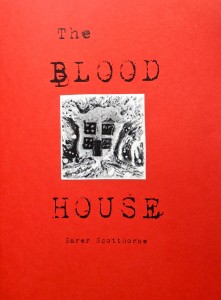Sarer Scotthorne has produced a bold and brilliant book – a poetic account of the struggle to re-assert sovereignty over the mind and body.

The Blood House is a metaphor, the body as the “place” in time we inhabit, in which we all live, and way of talking about mental and physical spaces. More specifically, The Blood House appears to be talking about the womb, where a woman is centred; the site where the feminine body is perhaps most empowered and also open to abuse (and misunderstanding). Although, the brain features heavily also.
Sarer employs terms of span and distance as measures upon which human interaction takes place, the ghost connections of sex, pregnancy and the unique relationship between a mother and her cubs; a voice trickling up the spine – proximity as the sense of gravity between people.
The method is most intriguing where the body’s (material) interior and exterior are at once the same subject. Where gestures are made and then withdrawn the subject, the author, haunts their own space, it is invaded, but also prodded and picked over as if by public post-mortem; bodies are judged by the standards and expectations of other bodies.
I loved the first poem, The Way Seagulls Fly, it is the best kind of poem – the experience of a sensation thrown into the air and reflected, as if in a mirror, in its many ways, the sheer now-ness of being is communicated:
Body loose, lonely bones
fleeing their centre, distorting themselves.
It quite literally echoes the wild inchoate gesture of taking flight.
There is a raw physicality, a brute adjunct of the poems laid out, sometimes as more concrete poetry, or retreating across the page, interjecting or allowing room to breathe. There is a pervading air of natural, existential claustrophobia, the desire to escape the Blood House – the prison of being, the stain of yourself:
It follows me and as I speak
it sprays from my mouth,
dirty shades – a shadow across my face.
Enjoyably, Sarer is not afraid to experiment and stretch forms and metres; and try to represent the lives of others. As in Soldier’s Dinner, where a maternal-eye-view picks apart a half day’s ration for a soldier in Afghanistan:
Tea trigger sparking hunger,
phantom pain of a child soldier
speaking tongues of discipline […]
Similar to Andrew McMillan’s recent book, “Physical”, The Blood House is all sensuality underscored by intent. The sometimes shared noise of interference and communication; roles our bodies force us to play and liberal splatterings of claret all coagulate into a vision of blood as both symptom and signs of life and the body at its best and worst.
The Blood House
by Sarer Scotthorne
The stairs creak voices – ketamine thuds bleed through
a single skin of brick; floorboards leak every secret.
The clock reverses – intermittent Gabba – radar moon. Cats scream,
I scream, howl my longings into cotton sheets. I scratch at the floor,
draw words in the mist of breath on pane; look through letters
lit orange by the light of the city night, at my beloved street below.
Bodies crawl, fumbling for keys – staring into shadows.
My hand-printed curtains float, lifting up as the city’s sweat billows into my room.
The shouts of children climb through my windows like burglars,
angry mother’s scream and drag them back out.
This house breathes for me – joists splintering with love,
the beat of slamming doors hides the sound of the past
that is buried alive in the red brick cellar below.
The Blood House
By Sarer Scotthorne
Published by Hesterglock Press (2015)
Available now: https://hesterglockpress.wordpress.com/blood/
Sarer Scotthorne is a feminist, poet and martial artist who plays with film and teaches Kung Fu and Creative Writing. She co-edits the poetry/flash fiction pamphlet Boscombe Revolution and Westside HERstory. Find out more about Sarer and her work: https://thebloodhouse.wordpress.com/
